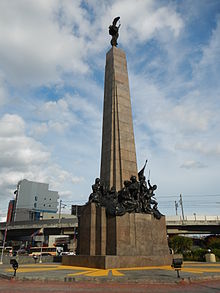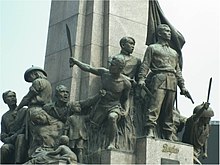Monument de la Légion Etrangère (Bonifacio)
Monumento ni Bonifacio | |
 | |
 | |
| 14°39′25″N 120°59′02″E / 14.65708°N 120.98397°E | |
| Location | Grace Park, Caloocan |
|---|---|
| Designer | Guillermo Tolentino |
| Height | 45 feet (14 m) |
| Beginning date | November 30, 1929 |
| Opening date | November 30, 1933 |
| Dedicated to | The memory of Andrés Bonifacio, Supremo of the Katipunan |
The Bonifacio Monument or Monumento is a memorial monument in Caloocan, Philippines which was designed by the National Artist Guillermo Tolentino to commemorate Philippine revolutionary Andrés Bonifacio, the founder and Supremo of the Katipunan. Andrés Bonifacio fought for independence from the politically and socially ruthless colonial rule by Spain.[1] The monument 45 feet (14 m) in height with symbolic images and other features known as the "Cry of Pugadlawin" is acclaimed as one of the best monuments in the world.[2][3]
Location
The monument is located on the Avenida Rizal, the old road leading to Manila at a roundabout crossing of four roads in Caloocan.[2]
History

The Bonifacio Monument recalls the Philippine Revolution which was spearheaded by Andres Bonifacio who had urged his men to raise against the colonial rule of Spain. His call to take arms against the Spanish rule was given on 23 August 1896, which is widely known as "Cry of Pugad Lawin."[4][2] The foundation stone for the monument was formally laid by Aurora Quezon, the wife of Filipino Senate President Manuel L. Quezon. The monument, which was created under the orders of Frank Murphy, the Governor-General, was inaugurated on 23 October 1933. It was inaugurated by the Speaker of the House, with much fanfare in a colourful function led by three women from Luzon (of the Women’s College), Visayas (of the Institute of Women), and Mindanao (of the Centro Escolar de Señoritas/Center for Women) with nine women attendants representing the eight provinces of Manila, Cavite, Batangas, Bulacan, Pampanga, Tarlac, Nueva Ecija, and Laguna which had participated in the revolution of 1896.[2]
On 30 November 2013, the "sesquicentennial" of birthday of Andres Bonifacio and the 80th anniversary of unveiling of the land mark monument to the Father of the Nation was celebrated. [2]
Features

The Bonifacio Monument, which was sculpted by Guillermo Tolentino in 1933, an obelisk, rises to a height of 45 feet (14 m); the obelisk is made up of five parts representing five aspects of the society, "Kataastaasan, Kagalanggalang na Katipunan ng mga Anak ng Bayan (Highest and Most Venerable Association of the Sons of the Nation)". It is crowned by a figure with wings representing triumph. Below the vertical pylon 23 figures cast in bronze have been molded over an octagonal shaped plinth. The octagon represents the eight provinces who fought against Spain and also represents eight rays of the Katipunan flag. The plinth is raised in three steps, each step representing the three centuries of Spanish rule. These figures are a representation of the people of Philippines, who faced inequality, agony and suppression under the colonial rule which eventually ended in an armed revolution in 1896. The main central image of the monument holds a bolo, a machete, in the right hand and a gun in the other hand. At the back of the central figure a flag of Katipunan in an unfurled state is depicted. A remarkable feature of the molded images of the human figures is the classic style with detailing marked by realistic expressions reflecting the revolutionary spirit with an "upright head and body" and with arms spread on the sides. The central obelisk is surrounded by pools of water. [2][5]
References
- ^ The Dynamic Teeners of the 21st Century Ii ' 2005 Ed. Rex Bookstore, Inc. p. 68. ISBN 978-971-23-4046-8.
- ^ a b c d e f "150th Birth Anniversary". Government of Philippines. Retrieved 16 November 2015.
- ^ Filipinas. Filipinas Pub. 2003. p. 20.
- ^ The Filipino Moving Onward 1' 2007 Ed. Rex Bookstore, Inc. pp. 58–. ISBN 978-971-23-4150-2.
- ^ Art: Perception & Appreciation. Goodwill Trading Co., Inc. pp. 294–. ISBN 978-971-11-0933-2.
